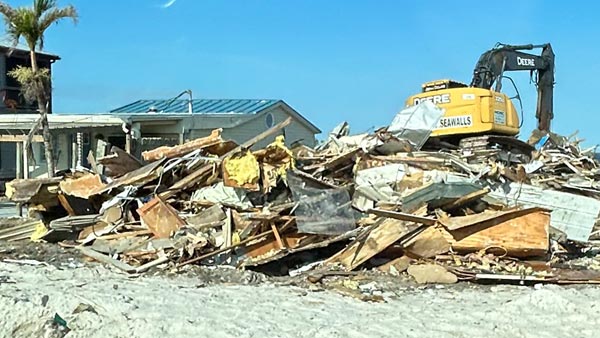Justin Battick ’25 is no stranger to those in need. During the pandemic, he collected food and drove it from his home in Holliston, Massachusetts, to Boston and Chelsea food pantries, where lines of people wrapped city blocks in the pouring rain for a share. As impactful as that experience was, it didn’t prepare him for what he found this January in Pine Island, Florida, when he led a Bryant group in cleanup efforts just four months after Hurricane Ian ravaged the Gulf Coast.
“It looks like something out of a movie,” says the Bryant sophomore. “It’s almost apocalyptic.”
The idea for the trip was borne after Ian smacked the Gulf Coast in late September, bringing category 4 winds and a catastrophic storm surge. A pal of Battick was forced to head home because his college, Bethune Cookman, in Daytona Beach, closed due to the impact.
Looking for guidance and funding, Battick approached Vice President of Student Affairs Inge-Lise Ameer with a proposal. Together they revised it, and funds were allocated from the Student Involvement Fund to cover transportation and lodging for a team of 12 (11 students and chaperone David Lockwood, from the Office of Counseling Services).
Adam Afragola ’25, a finance major from Guilford, Connecticut, signed on.
“When I told family I was going to Florida for hurricane relief, they were confused,” he says. “To the average person, you think a hurricane that happened months ago would be nearly settled by now. In New England, I have never been through anything even close to this level of devastation.”
From their rented house in Cape Coral, Florida, the Bryant crew packed themselves into two seven-passenger vans daily for the short drive to Pine Island. The contrast in conditions from inland to island was stark.
“You cross the bridge onto Pine Island and the houses are just obliterated,” says Battick. “It’s like two different worlds. You wouldn’t think a house had even been there. It doesn’t seem possible to clean up that much mess.”

The largest island in Florida, Pine Island is just 17 miles long and 2 miles wide. With about 8,000 residents and no beaches, it’s not a tourist destination. Before Ian, the island was known for fishing, tropical fruit groves, and commercial nurseries.
“It’s very depressing. The people are trying to move forward but it’s going to take energy,” says Battick. “It will have to be rebuilt as a whole new community, like post-war.”
Over four days, the Bryant team worked with the local American Legion on six houses, with the Legion providing gear: shovels, trash bags, and the protective suits and respirators needed for the dirty, dangerous job of ripping out mold-infested drywall. The deadly storm surge pushed water levels four feet high, island wide. Since the damage was from flooding, most residents don’t have coverage from their insurance.
For Christian Hamel ’25, the wreckage was surprising.
“There were still cars under buildings, houses underwater, and in many areas the woods were covered in plastic and rubbish,” says Hamel, a finance major from Boxford, Mass. “I saw not only physical destruction, but mental destruction as well. Seeing the way people were psychologically affected was eye-opening.”

For counselor David Lockwood, the conditions were a reminder of what he witnessed while serving in the Peace Corps in 1998, helping relief efforts in Nicaragua after Hurricane Mitch.
“Mitch was a category 5 storm that affected the entire Central American peninsula. The damage in Florida was as impressive as what I experienced there,” he recalls. “To see residents of the island living in emergency conditions four months after the storm was very surprising. Residents continue to lack access to electricity, housing, and clean water.”
Battick captured some of those personal stories of loss and heartbreak in powerful interviews he conducted on site.
“Nobody smiles because they’re getting no help. They’re so defeated,” he says. “The people were so friendly, though, and grateful for our help. They would ask us, ‘Are you getting paid? Are you getting class credit?’ We told them: ‘No, we’re just here to help.’”
The trip was so meaningful to Battick—and the need is so great—that he organized a second group to return and continue cleanup efforts over spring break. They leave Saturday, March 11.